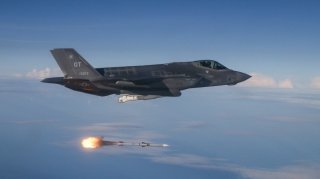Top Gun: A New Training System Will Prepare Pilots for Aerial Combat
Advances in computer technology make it possible for simulations to replicate enemy aircraft, weapons, and maneuver tactics.
Executing quick maneuvers during air combat to avoid incoming enemy fire, shifting course to avoid collisions, and drawing on advanced artificial intelligence (AI) enabled computer algorithms to process enemy targeting data are all critical areas of focus for U.S. Air Force trainers as they prepare for great power war.
Future air combat will incorporate more speed, range, stealth, and lethality, as well as new levels of autonomy, making the need to prepare for and train against a wide range of contingencies extremely critical. This concept forms the basis of the U.S. Air Force’s Red Team training concept where groups of air platforms confront specific anticipated enemy threats in realistic combat scenarios. Increasingly, advances in computer technology make it possible for simulations to replicate enemy aircraft, weapons, maneuver tactics, and even computing power through advanced computer simulations.
It is a training focus increasingly emphasized by the U.S. Air Force and U.S. Navy in close coordination with live-fire training scenarios through exercises such as Red Flag. As part of this integrated process, training through simulated networking technologies is being measurably improved by the U.S. Air Force in coordination with industry partners.
Cubic Mission and Performance Solutions, a division of Cubic Corporation, was recently awarded a U.S. Air Force contract for its P5 Combat Training System (P5CTS). The P5 System Security Update (SSU), a drop-in encryption solution is part of a larger technology upgrade intended to massively improve U.S. Air Force and U.S. Navy pilot training for advanced, high-threat combat scenarios using advanced computer simulations, wireless networks, and AI-enabled data organization.
Interestingly, the recently released Top Gun Maverick movie is being widely praised for its accurate portrayal of cutting-edge military technology and Tom Cruise’s F/A-18 fighter is shown with a P5 Pod on it during the movie.
P5 SSU, Cubic explained, will be able to encrypt the Time, Space, and PositionInformation used to train with hundreds of operational F-35 stealth fighters in coordination with fourth-generation aircraft, enabling larger formations and secure collaborative training across a disaggregated force. The technical infrastructure informing Cubic’s P5 is designed to enable secure networking of data, in part through the use of software upgrades and common internet protocol standards. “Cubic’s P5 SSU solution features a low-risk, flight-proven, National Security Agency (NSA)-certified Type 1 multilevel encryptor that enables or restricts the access and transfer of information between security domains on the P5CTS without modifying the current training Concept of Operations,” a Cubic statement said.
With P5 SSU, fourth-generation aircraft will be capable of training securely with over 900 fifth-generation F-35s already equipped with encrypted P5 to protect the Techniques, Tactics, and Procedures from enemy exploitation, a Cubic statement said. “Cubic’s current P5CTS/TCTS allows aircrew to train anywhere, anytime and capture live training truth data for post mission analysis and debriefing,” Mike Knowles, president of Cubic Mission and Performance Solutions, noted.
Kris Osborn is the Defense Editor for the National Interest. Osborn previously served at the Pentagon as a Highly Qualified Expert with the Office of the Assistant Secretary of the Army—Acquisition, Logistics & Technology. Osborn has also worked as an anchor and on-air military specialist at national TV networks. He has appeared as a guest military expert on Fox News, MSNBC, The Military Channel, and The History Channel. He also has a Master's Degree in Comparative Literature from Columbia University.
Image: Flickr/U.S. Air Force.

